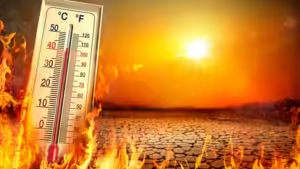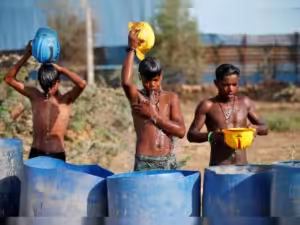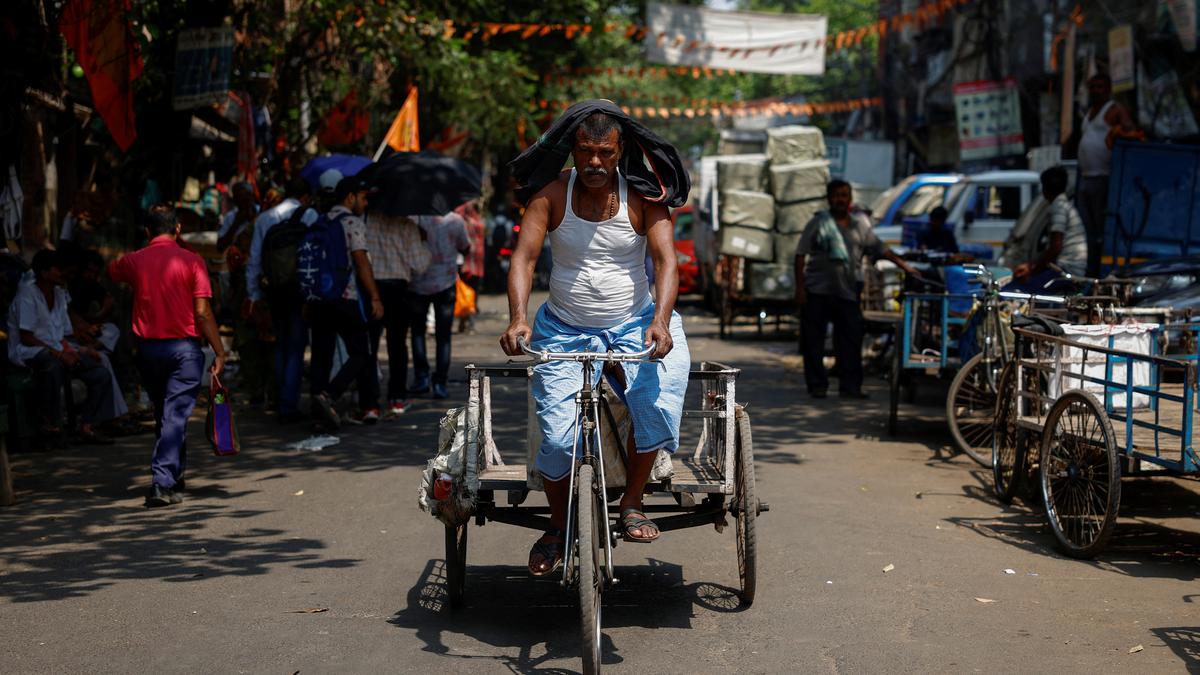Northern plains and central India are expected to witness a high number of heat wave days in May, according to the Indian Meteorological Department (IMD).
A heat wave is characterized by abnormally high temperatures exceeding the typical maximum during the summer season, primarily observed in the North-Western parts of India. These occurrences, often transpiring between March and June, with occasional extensions into July, significantly impact the populace by inducing physiological stress and, in severe cases, fatalities.
IMD outlines specific criteria for identifying heat waves:
- Heat waves are not acknowledged until the maximum temperature of a station reaches at least 40°C for plains and at least 30°C for hilly regions.
- For stations where the normal maximum temperature is equal to or less than 40°C, a departure from the norm of 5°C to 6°C constitutes a heat wave, while a departure of 7°C or more is considered severe.
- When the normal maximum temperature exceeds 40°C, a deviation of 4°C to 5°C signifies a heat wave, while a deviation of 6°C or more denotes a severe heat wave.
- Additionally, if the actual maximum temperature remains at 45°C or higher, irrespective of the normal maximum temperature, it qualifies as a heat wave.
The adverse effects of heat waves encompass dehydration, heat cramps, heat exhaustion, and potentially fatal heat stroke. Symptoms range from swelling and fainting to fatigue, weakness, dizziness, headache, nausea, vomiting, muscle cramps, and profuse sweating. Heat stroke, characterized by a body temperature of 40°C or more, may lead to delirium, seizures, or coma.
Immediate measures to aid those affected by heat include relocating them to a cool, shaded area, providing water or rehydrating beverages, fanning, and loosening clothing for improved ventilation. Medical consultation is essential if symptoms worsen or persist, or if the individual loses consciousness.
In April, active Western Disturbances mitigated heat waves by inducing rain, thunderstorms, and hailstorms across northern and central India. However, the IMD anticipates above-normal maximum temperatures in May, particularly in the northern plains, central regions, and adjacent areas of peninsular India. This projection indicates a substantial increase in the number of heat wave days compared to the historical average.
The prevalence of prolonged and intense heat waves underscores the impact of climate change, exacerbating their frequency and severity over time. The IMD warns of a continuation of this trend, with certain regions expected to experience eight to eleven heat wave days in May alone.
As the nation braces for heightened temperatures, it is imperative to prioritize public health and safety measures. Authorities must remain vigilant and proactive in addressing the challenges posed by escalating heat waves, especially considering the potential implications for critical events such as elections.
Health Impacts of Heat Waves
The health impacts of Heat Waves typically involve dehydration, heat cramps, heat exhaustion and/or heat stroke. The signs and symptoms are as follows:
- Heat Cramps: Ederna (swelling) and Syncope (Fainting) generally accompanied by fever below 39°C i.e.102°F.
- Heat Exhaustion: Fatigue, weakness, dizziness, headache, nausea, vomiting, muscle cramps and sweating.
- Heat Stoke: Body temperatures of 40°C i.e. 104°F or more along with delirium, seizures or coma. This is a potential fatal condition
Recover and Build
If you think someone is suffering from the heat:
- Move the person to a cool place under the shade
- Give water or a rehydrating drink (if the person is still conscious)
- Fan the person
- Consult a doctor if symptoms get worse or are long lasting or the person is unconscious
- Do not give alcohol, caffeine or aerated drink
- Cool the person by putting a cool wet cloth on his/her face/body
- Loosen clothes for better ventilation
Emergency Kit
- Water bottle
- Umbrella/ Hat or Cap / Head Cover
- Hand Towel
- Hand Fan
- Electrolyte / Glucose / Oral Rehydration

Did you Know: ACs are now available for smaller rooms which are below 1 ton (one ton) ? These can be a budget option for you! Find out more from the amazon link below,
https://amzn.to/3QnW4ZN
Straight from IMD:
Five active Western Disturbances led to rain, thunderstorm, and hailstorms over north and central India at regular intervals in April, preventing heat waves, the IMD said,
Above normal maximum temperatures are likely over most parts of the country in May and a significantly high number of heat wave days expected over the northern plains, central region, and adjoining areas of peninsular India, said IMD chief Mrutyunjay Mohapatra on May 1.
A prolonged and intense spell of heat wave scorched swathes of east, northeast, and southern peninsular India in April, prompting health warnings from government agencies and some States to suspend in-person classes in schools.
Five active Western Disturbances led to rain, thunderstorm, and hailstorms over north and central India at regular intervals in April, preventing heat waves, the India Meteorological Department’s director general told a press conference.
IMD data shows that the heat waves in April this year were far worse than in 2023, the warmest year on record so far.
This trend is likely to continue in May, with around eight to 11 heat wave days predicted over south Rajasthan, west Madhya Pradesh, Vidarbha, Marathwada, and Gujarat regions, Mr. Mohapatra said.
The remaining parts of Rajasthan, east Madhya Pradesh, Punjab, Haryana, Chandigarh, Delhi, Uttar Pradesh, and some parts of Chhattisgarh, interior Odisha, Gangetic West Bengal, Jharkhand, Bihar, north interior Karnataka, and Telangana may record five-seven heat wave days in the month, he said.
Normally, the northern plains, central India, and adjoining areas of peninsular India experience around three days of heat waves in May.
Above normal maximum temperatures are likely over most parts of the country in May, except for most parts of northeast India, some parts of northwest and central India, and adjoining areas of northeast peninsular India where normal to below-normal maximum temperatures are likely, the IMD said.
Above normal minimum temperatures are likely over most parts of the country except the northeast and some areas of northwest India, Indo-Gangetic plains, and the central region.
Normal rainfall (91-109 per cent of the long-period average) is predicted in the country in May. Normal to above normal rainfall is likely over most parts of northwest India, and some parts of central, peninsular and northeast India. Below normal precipitation is likely in the remaining parts of the country, the IMD said.
India saw two spells of heat waves in April — from April 5 to 7 and April 15 to 30.
Mr. Mohapatra attributed the prolonged heat wave spell over east, northeast, and south peninsular India in April to the absence of thunderstorms and a persisting anticyclone at lower levels over the west central Bay of Bengal and the adjoining eastern coasts of India.
This caused the sea breeze to cut off over Odisha and West Bengal on most days, he said.
The IMD said south peninsular India recorded an average maximum temperature of 31 degrees Celsius in April, which was the second-highest since 1901.
The mean temperature (28.12 degrees Celsius) in April in east and northeast India was the highest since 1901, the weather office said.
The IMD chief said above normal maximum temperatures have become frequent over south peninsular India since 1980s. The region recorded 12.6 mm of rainfall in April, which was the fifth lowest since 1901 and the second lowest since 2001.

Mr. Mohapatra said the number of heat wave days this April was the highest in 15 years in Gangetic West Bengal and nine years in Odisha.
Odisha also experienced the longest heat wave spell (16 days) in April since 2016.
Amid the prevailing but weakening El Nino conditions, the IMD had earlier warned of extreme heat during the April-June period, coinciding with the seven-phase Lok Sabha elections.
Hundreds of thousands of voters had to cope with the searing heat when they stepped out to exercise their franchise in the second phase of the Lok Sabha elections on April 26. Polling for 94 constituencies across 12 States will take place on May 7.
The weather office had earlier expected four to eight heat wave days in different parts of the country in April against a normal of one to three days. Ten to 20 heat wave days are expected against a normal of four to eight in the entire April June period.
Following a decrease in turnout in the first phase of polling, the Election Commission (EC) set up a task force to review the impact of the heat wave.
The task force includes officials of the poll panel, the IMD, the National Disaster Management Authority (NDMA), and the Union Health and Family Welfare Ministry.
Given the Central government’s contemplation of the ‘one nation, one-poll’ concept, the IMD chief had earlier told PTI that authorities must consider weather conditions and the climate in their planning. ‘One nation, one poll’ refers to the idea of holding simultaneous polls in the country to elect Lok Sabha and state assembly representatives.

Advisory for State Health Department on Heat Wave Season 2024:
https://ncdc.mohfw.gov.in/wp-content/uploads/2024/03/Advisory-for-State-Health-Department-on-heat-wave-season-2024_NPCCHH.pdf
Current Temperature Status and Heat Wave Warning:
https://internal.imd.gov.in/pages/heatwave_mausam.php
Guidelines on Emergency Cooling for Severe Heat-Related Illnesses:
https://ncdc.mohfw.gov.in/wp-content/uploads/2024/03/Emergency-Cooling-for-Severe-Heat-Related-Illnesses_March2024_NPCCHH.pdf
Public Health Advisory (Do’s and Don’ts): Extreme Heat/Heat Wave 2024:
https://ncdc.mohfw.gov.in/wp-content/uploads/2024/03/NPCCHH_Public-health-advisory_Extreme-heat_Heatwave_2024.pdf
